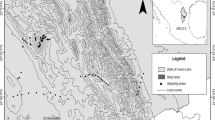Abstract
An ecological ordination model of higher units of steppe vegetation in the mountains of the southern Middle Siberia was created based on indirect ordination (detrended correspondence analysis) of 326 complete geobotanical descriptions and on a correlation analysis of the values of main axes with climatic, soilground, and geographical parameters. Ecological series of coenofloras of the steppe vegetation are observed in the space of the two first leading axes of ordination. They are oriented by climatic factors of the annual and seasonal precipitation amounts, temperature, oceanity–continentality, and substrate rockiness. A syntaxonomic interpretation of the observed ecological-geographical steppe types is given, and a hierarchy of higher classification units is substantiated from ecological positions.
Similar content being viewed by others
References
Box, E.O, Macroclimate and plant forms: an introduction to predictive modeling in phytogeography, in Tasks for Vegetation Science, London: Dr. W. Junk, 1981, vol. 1.
Cherepanov, S.K., Vascular Plants of Russia and Adjacent States (the Former USSR), Cambridge: Cambridge Univ. Press, 1995.
Chytrý, M., Danihelka, J., Ermakov, N., et al., Plant species richness in continental southern Siberia: effects of pH and climate in the context of the species pool hypothesis, Global Ecol. Biogeogr., 2007, vol. 16, pp. 668–678.
Ermakov, N.B., Raznoobrazie boreal’noi rastitel’nosti Severnoi Azii. Kontinental’nye gemiboreal’nye lesa: Klassifikatsiya i ordinatsiya (Diversity of Boreal Vegetation of the Northern Asia. Continental Hemiboreal Forests: Classification and Ordination), Novosibirsk: Sib. Otd., Ross. Akad. Nauk, 2003.
Ermakov, N.B, Prodromus of Russian vegetation, in Sovremennoe sostoyanie osnovnykh kontseptsii nauki o rastitel’nosti (Modern Status of General Scientific Concept about Vegetation), Ufa: Gilem, 2012a, pp. 377–483.
Ermakov, N.B, Higher syntaxa of xerophilous and deserted steppes of Southern Siberia and Mongolia, Vestn. Novosib. Gos. Univ., Ser. Biol. Klin. Med., 2012b, vol. 10, no. 2, pp. 5–15.
Ermakov, N., Dring, J., and Rorwell, J, Classification of Continental Hemiboreal Forests of North Asia, Camerino, 2000, vol. 28.
Ermakov, N.B., Larionov, A.V., and Polyakova, M.A, Syntaxa of meadow steppe of Helictotrichetalia schelliani from Altai and Khakassia, Vestn. Novosib. Gos. Univ., Ser. Biol. Klin. Med., 2012, vol. 10, no. 2, pp. 16–23.
Ermakov, N., Larionov, A., Polyakova, M., Pestunov, I., and Didukh, Ya., Diversity and spatial structure of cryophytic steppe of the Minusinskaya basin in Southern Siberia (Russia), Tuexenia, 2014, vol. 34, pp. 431–446.
Ermakov, N.B., Polyakova, M.A., and Smorgov, A.E, Associations of petrophytic steppe communities from Atai-Sayan mountain region. 1. Communities of Selaginella sanguinolenta of Western Sayan and Tuva, Vestn. Novosib. Gos. Univ., Ser. Biol. Klin. Med., 2009, vol. 7, no. 4, pp. 35–42.
Hennekens, S.M., TURBO(VEG). Software Package for Input, Processing, and Presentation of Phytosociological Data. User’s Guide, Lancaster: Univ. of Lancaster, 1996.
Hill, M.O., DECORANA and TWINSPAN, for Ordination and Classification of Multivariate Species Data: A New Edition, Together with Supporting Programs, in FORTRAN 77, Huntingdon: Inst. Terr. Ecol., 1979.
Hilbig, W, Pflanzengesellschaften der Mongolei Wiss, Z. Univ. Halle, 1990, vol. l, no. 39, pp. 1–146.
Hilbig, W, The plant communities of Mongolia, in The Vegetation of Mongolia, Amsterdam: SPB Acad., 1996, pp. 34–233.
Ignatov, M.S. and Afonina, O.M., Check-list of mosses of the former USSR, Arctoa, 1992, vol. 1, nos. 1–2, pp. 1–85.
Korolyuk, A.Yu., Vegetation, in Stepi Tsentral’noi Azii (Steppes of Central Asia), Khmelev, V.A., Ed., Novosibirsk: Sib. Otd., Ross. Akad. Nauk, 2002, pp. 45–94.
Korolyuk, A.Yu. and Makunina, N.I, Xerophilous steppes of Altai-Sayan mountain region, Rastit. Mir Aziat. Ross., 2009, vol. 4, no. 2, pp. 452–461.
Krestov, P.V., Ermakov, N.B., Osipov, S.V., and Nakamura, Y, Classification and phytogeography of larch forests of northeast Asia, Folia Geobot., 2009, vol. 44, no. 4, pp. 323–363.
Krestov, P.V., Omelko, A.M., and Nakamura, Y, Phytogeography of higher units of forests and krummholz in North Asia and formation of vegetation complex in the Holocene, Phytocoenologia, 2010, vol. 40, no. 1, pp. 41–56.
Kuminova, A.V., Sedel’nikov, V.P., Maskaev, Yu.M., et al., Rastitel’nyi pokrov i estestvennye kormovye ugod’ya Tuvinskoi ASSR (Vegetation Cover and Natural Fodder Resources of Tuva ASSR), Novosibirsk: Nauka, 1985.
Kuminova, A.V., Zvereva, G.A., Maskaev, Yu.M., Pavlova, G.G., et al., Rastitel’nyi pokrov Khakasii (Vegetation Cover of Khakassia), Novosibirsk: Nauka, 1976.
Lapshina, E.I., Karta rastitel’nosti yugo-vostoka Zapadnoi Sibiri (Map of Vegetation of the Southeast of Western Siberia), Moscow: Glav. Uprav. Geodez. Kartogr., 1963.
Lavrenko, E.M., Karamysheva, Z.V., and Nikulina, R.I., Stepi Evrazii (Eurasian Steppes), Leningrad: Nauka, 1991.
Makunina, N.I, Steppes of Minuskinsk intermountain depressions, Turczaninowia, 2006, vol. 9, no. 4, pp. 112–144.
Mirkin, B.M., Manibazar, N., Mukhametshina, V.S., Alimbekova, L.M., and Onishchenko, L.I, Vtoroe priblizhenie klassifikatsii rastitel’nosti rechnykh poim MNR. VII. Obshchaya kharakteristika i obzor klassa Cleistogenetea squarrosae kl. nova. Poryadok Cleistogenetalia squarrosae ord. nova. Soyuzy Cleistogenion squarrosae all. nova i Thymion gobici all. nova (Second Attempt to Classify the River Plain Vegetation of People’s Republic of Mongolia. VII. General Characteristic and Review of Class Cleistogenetea squarrosae kl. nova. Order Cleistogenetalia squarrosae ord. nova. Unions Cleistogenion squarrosae all. nova and Thymion gobici all. nova), Available from VINITI, 1985, Moscow, no. 3356-V85.
Mirkin, B.M., Rozenberg, G.S., and Naumova, L.G., Slovar’ ponyatii i terminov sovremennoi fitotsenologii (Dictionary of Definitions and Terms of Modern Phytocenology), Moscow: Nauka, 1989.
Nazimova, D.I., Andreeva, N.M., Kofman, G.B., et al., Models of structural biodiversity of forest cover, in Bioraznoobrazie i dinamika ekosistem: informatsionnye tekhnologii i modelirovanie (Biodiversity and Dynamics of Ecosystems: Information Technologies and Modeling), Novosibirsk: Sib. Otd., Ross. Akad. Nauk, 2006, pp. 154–157.
Nazimova, D.I., Korotkov, I.A., and Cherednikova, Yu.S., General high-altitude division of forest cover in the mountains of Southern Siberia and their diagnostics, in Struktura i funktsionirovanie lesnykh biogeotsenozov Sibiri (Structure and Functions of Forest Biogeocenosises of Siberia), Moscow: Nauka, 1987, pp. 30–64.
Nazimova, D. and Polikarpov, N, Forest zones of Siberia as determined by climatic zones and their possible transformation trends under global change, Silva Fen., 1996, vol. 30, nos. 2–3, pp. 201–208.
Parfenova, E.I. and Tchebakova, N.M., Bioclimatic distribution pattern of phytomass and biodiversity in steppes of Southern Siberia, in Mater. I mezhdunar. nauchnoprakt. konf. “Bioraznoobrazie i sokhranenie genofonda flory, fauny i narodonaseleniya Tsentral’no-Aziatskogo regiona,” Kyzyl, 23–28 sentyabrya 2002 g. (Proc. I Int. Sci.-Pract. Conf. “Biological Diversity and Conservation of Gene Pool of Flora, Fauna, and Humans in Central Asian Region,” Kyzyl, September 23–28, 2002), Kyzyl: Tuvinsk. Gos. Univ., 2003, pp. 59–60.
Polevaya geobotanika (Field Geobotany), Lavrenko, E.M. and Korchagin, A.A, Eds., Leningrad: Nauka, 1964, vol. 3.
Polikarpov, N.P., Tchebakova, N.M., and Nazimova, D.I., Klimat i gornye lesa Yuzhnoi Sibiri (Climate and Mountain Forests of Southern Siberia), Novosibirsk: Nauka, 1986.
Prentice, I., Cramer, W., Harrisson, S., et al., A global biome model based on plant physiology and dominance, soil properties and climate, J. Biogeogr., 1992, vol. 19, pp. 117–134.
Sochava, V.B., Rastitel’nyi pokrov na tematicheskikh kartakh (Vegetation Cover on Thematic Maps), Novosibirsk: Nauka, 1979.
Spravochnik po klimatu SSSR (Handbook on Climate of Soviet Union), Leningrad: Gidrometeoizdat, 1967, no. 21, part 4.
Tchebakova, N.M., Monserud, R.A., and Nazimova, D.I, A Siberian vegetation model based on climatic parameters, Can. J. For. Res., 1994, vol. 24, pp. 1597–1607.
Tchebakova, N.M. and Parfenova, E.I, Re-distribution of vegetation in the Baikal Lake basin at possible climate warming, Geogr. Prirod. Resur., 2000, no. 1, pp. 64–68.
Tchebakova, N.M. and Parfenova, E.I, Forecast of forest border shift in Central Siberia caused by climate change by the end of 20th century, Vychislit. Tekhnol., 2006, vol. 11, part 3, pp. 77–86.
Tchebakova, N.M., Refeld, J., and Parfenova, E.I., Re-distribution of vegetation zones and population of Siberian larch and Scots pine in Central Siberia caused by climate change, Sib. Ekol. Zh., 2003, no. 6, pp. 677–686.
Weber, H.E., Moravec, J., and Theurillat, J.-P., International code of phytosociological nomenclature, J. Veg. Sci., 2000, vol. 11, pp. 739–768.
Westhoff, V. and van der Maarel, E., The Braun-Blanquet approach, in Handbook of Vegetation Science, Vol. 5: Classification and Ordination of Communities, Whitteker, R.H., Ed., Hague: Junk,1973, pp. 617–726.
Author information
Authors and Affiliations
Corresponding author
Additional information
Original Russian Text © N.B. Ermakov, A.V. Larionov, M.A. Polyakova, Yu.V. Plugatar, 2016, published in Zhurnal Obshchei Biologii, 2016, Vol. 77, No. 4, pp. 293–302.
Rights and permissions
About this article
Cite this article
Ermakov, N.B., Larionov, A.V., Polyakova, M.A. et al. Ecological interpretation of higher units of steppe vegetation in the mountains of southern Middle Siberia by quantitative ordination. Biol Bull Rev 7, 229–237 (2017). https://doi.org/10.1134/S2079086417030033
Received:
Published:
Issue Date:
DOI: https://doi.org/10.1134/S2079086417030033




